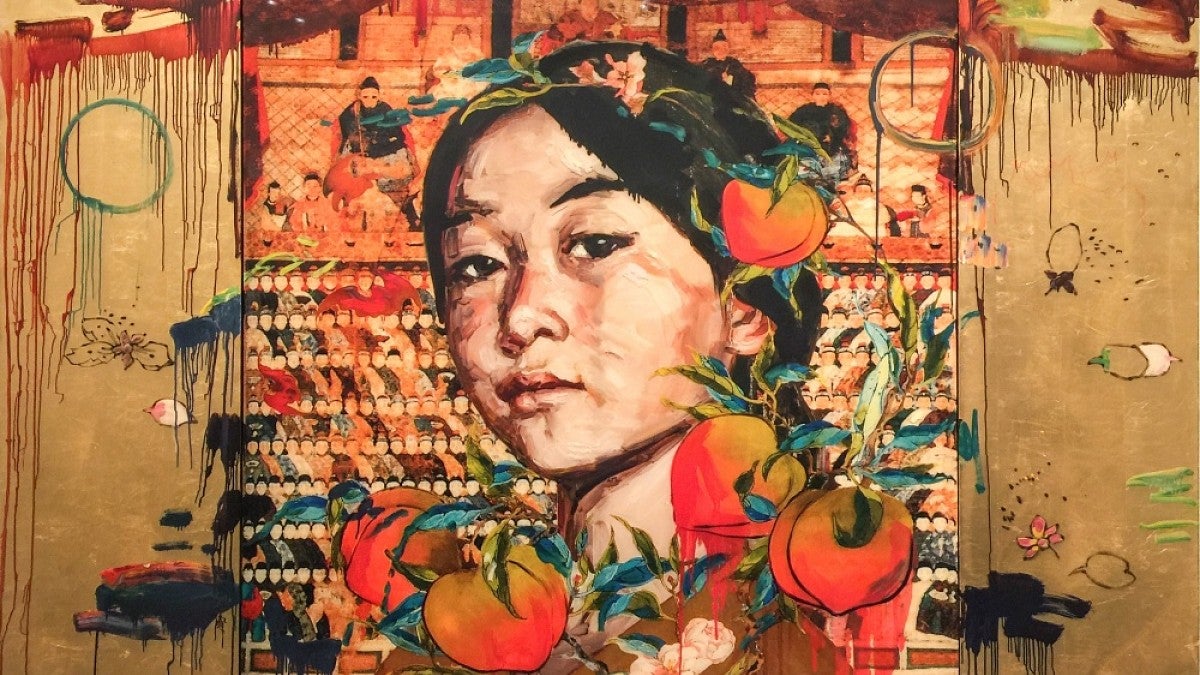Renowned contemporary Chinese artist Hung Liu and Trillium Graphics master printer David Salgado have donated 55 works of art to the University of Oregon’s Jordan Schnitzer Museum of Art.
The artworks exemplify the innovative mixed-media techniques the two developed in which printed and painted elements are embedded in layers of resin to create an evocative, gestural effect.
“The JSMA’s traditional Chinese collection forms the foundation of our holdings, but we have few works by contemporary Chinese artists,” said Jill Hartz, the museum’s executive director. “This is a truly transformative gift that will strengthen our collection and enhance both research and teaching by our curators, faculty and students for years to come.”
According to Anne Rose Kitagawa, the art museum’s chief curator and curator of Asian art, “Because these works bridge the gap between traditional printmaking and painting, Hung playfully refers to them as ‘za zhong,’ or ‘bastard paintings,’ acknowledging their hybrid nature.”
Developed for the artist as a proprietary technique by Trillium Graphics, the process uses a medium of transparent resin that allows the layering of images and gestures embedded in Liu’s oil paintings and other works to fully reveal themselves.
“Liu’s subject matter references traditional China — especially women’s history — politics, cultural identity, memory, displacement and social justice,” Kitagawa said. “Through her art she imparts dignity upon ignored or reviled members of society.”
In 2011, in recognition of the za zhong works produced at Trillium Graphics, Liu received the lifetime achievement in printmaking award from the Southern Graphics Council. Trillium is the proprietary owner and publisher of the za zhong works.
“I am gratified to donate so many of my za zhong works to the Jordan Schnitzer Museum of Art,” Liu said. “I love the museum, because it is such a unique institution with women at the helm. Its first director, Gertrude Bass Warner, was a museum specialist and a collector of Asian art. The current director, Jill Hartz, and the chief curator of collections and Asian art, Anne Rose Kitagawa, are helping take the museum into the 21st century."
The museum had no works by Liu before the donation, Kitagawa said.
“Given our museum’s historic Chinese legacy collection and humanitarian mission, both inspired by founder Gertrude Bass Warner, we are honored to have been chosen as the major repository of Liu’s printed art,” she said
A Professor Emerita at Mills College in California, Liu is known primarily for her rich, colorful paintings based on historical photographs of Chinese prostitutes, refugees, street performers, soldiers, laborers, prisoners and children, which she envelopes in veils of dripping linseed oil that, in her words, “both preserve and destroy the image.” In this way, she invents what she calls “weeping realism” that brings faded photos back to life, “summons ghosts,” and expresses the passage of time and the erosion of memory.
Liu was born in Changchun, China, in 1948 and grew up in Beijing during the Cultural Revolution. Following her high school graduation in 1968, she was sent to labor in the countryside for four years as part of Mao Zedong’s plan to “re-educate” members of the intellectual class. During this time, she photographed and drew portraits of peasant farmers and their families.
In 1972, she went to study art and education at the Revolutionary Entertainment Department of Beijing’s Teachers College, graduating in 1975. She then taught at the Jing Shan School and hosted a weekly televised art lesson, “How to Draw and Paint.”
She received her Master of Fine Arts from the University of California, San Diego, in 1986. In 1991, she returned to China and discovered a treasure trove of turn-of-the-century photos of Chinese prostitutes, which became primary source material for a series of paintings.
David Salgado is the founder, director and owner of Trillium Graphics. Trillium has been making prints and creating cast resin mixed media with prominent bay area artists since 1979.
The museum plans to use the Hung Liu za zhong acquisitions for a series of courses that will culminate in a special exhibition produced in collaboration with UO faculty and students.
Two of the works are now on display, one in the Chinese exhibition “Reflections of the Cosmic Web: Intricate Patterns in Daoist Art,” on view through April 2019, and the other in the recent-acquisitions show, “A Decade of Collecting,” on view through Sept. 2.


